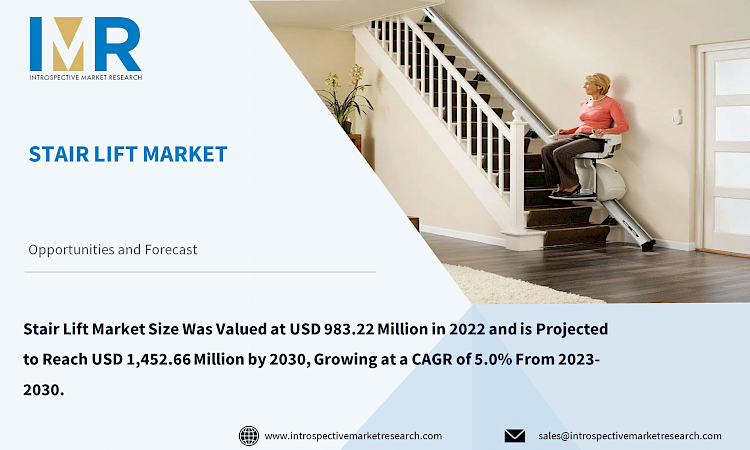
Introduction to Stair Lift:
Stair Lift Market Size Was Valued at USD 983.22 Million in 2022 and is Projected to Reach USD 1,452.66 Million by 2030, Growing at a CAGR of 5.0% From 2023-2030.
The stair lift market refers to the industry involved in the design, manufacturing, and distribution of mobility aids specifically designed to assist individuals with mobility challenges in navigating stairs within their homes or other relevant spaces. Stair lifts are motorized devices that are typically installed on staircases, allowing users to comfortably and safely move up and down stairs without the need for physical exertion or assistance from others. These devices have gained prominence due to their ability to enhance independence and quality of life for seniors and individuals with mobility impairments, enabling them to remain in their homes and access different levels of their residences with ease The stair lift market has experienced substantial growth in recent years, driven by a combination of factors such as an aging population, increasing awareness about accessibility and inclusive design, and technological advancements in the field. As societies continue to age, the demand for stair lifts is expected to rise, with a growing number of individuals seeking solutions that promote aging in place. innovation in design and features, including ergonomic and user-friendly controls, enhanced safety measures, and aesthetic improvements, are reshaping the market. Additionally, efforts to make these devices more energy-efficient and environmentally friendly are aligning with broader sustainability trends in the mobility industry. The stair lift market is thus characterized by a dynamic landscape with opportunities for manufacturers to cater to evolving customer needs and preferences while contributing to improved accessibility and independence for users.
Major Key Players:
- Acorn Stairlifts Inc.
- AmeriGlide
- Ascent Mobility
- Bruno Independent Living Aids Inc.
- EHLS
- a Lifeway Mobility Company
- Gruppo Millepiani S.p.a
- Handicare Group AB
- Harmar Mobility LLC
- HIRO LIFT (Hillenkötter + Ronsieck)
- Kumalift Co. Ltd.
- Lehner Lifttechnik GmbH
- Otolift Stairlifts Ltd.
- Platinum Stair Lifts Ltd.
- Prism U.K. Medical Limited
- Qingdao Sinofirst Machinery Co. Ltd.
- Savaria Corp.
- Stannah Lifts Holdings Ltd
- Symax Lift Co Ltd.
- Taamal Mizra Electra
- ThyssenKrupp AG
Market Dynamics and Factors Influencing Growth:
Drivers:
The stair lift market is the rapidly aging global population. As demographics shift, there is a growing cohort of elderly individuals who wish to maintain their independence and age in place within their own homes. Stair lifts provide a vital solution for this demographic by enabling them to navigate stairs safely and comfortably, reducing the need for costly home modifications or relocation to assisted living facilities. This demographic trend, often referred to as the "silver tsunami," is driving substantial demand for stair lifts, making them a critical tool for seniors looking to retain their mobility and autonomy. A significant driver is increased awareness and advocacy for accessibility and inclusivity. Governments, organizations, and communities are becoming more proactive in promoting accessible living environments for people with disabilities and seniors. Stair lifts play a pivotal role in these efforts, making homes and public spaces more accommodating for individuals with mobility challenges. Additionally, regulations and building codes are evolving to emphasize accessibility, further stimulating the demand for stair lifts as a key component of these compliance measures. This heightened focus on creating accessible spaces ensures a growing market for stair lifts as they become integral in fostering a more inclusive and accommodating society.
Restraints:
the stair lift market is the high initial cost associated with purchasing and installing these devices. Stair lifts can be a significant financial investment for individuals, particularly for those on fixed incomes or with limited resources. The upfront expenses may deter potential users or require them to seek alternative, less costly solutions, such as home modifications or living on a single level, which can limit market growth. Addressing affordability and exploring funding options will be crucial to expanding the adoption of stair lifts and mitigating this restraint.
Opportunities:
The stair lift market is the expansion of product offerings and features to cater to a wider range of customer needs. Innovations in design, technology, and customization can allow manufacturers to target various demographics, including younger individuals with temporary mobility issues or those seeking more aesthetically pleasing and space-efficient solutions. By providing a diverse range of products, from basic models to high-end, advanced systems, manufacturers can tap into a broader customer base and enhance market penetration. The global focus on sustainability and environmental consciousness presents an opportunity for the stair lift market to explore eco-friendly solutions. Developing energy-efficient stair lifts with reduced environmental impact can not only appeal to environmentally conscious consumers but also align with government regulations and green building standards. Embracing sustainable materials, energy-efficient components, and recycling initiatives can differentiate manufacturers in the market, attract a growing segment of eco-conscious customers, and contribute to the long-term growth and sustainability of the stair lift industry as urbanization continues and populations grow in various regions across the world, there is untapped market potential in many areas where stair lift adoption may be relatively low. Manufacturers can explore partnerships, distribution agreements, and localized marketing strategies to make stair lifts more accessible and affordable in emerging markets and regions with aging populations.
Stair Lift Market Segmentation:
By Rail Type
- Straight
- Curved
- Platform
By User Orientation
- Seated
- Standing/Perched
- Integrated Wheelchair Platform
By Application
- Residential Spaces
- Commercial Spaces
Rail Type: The rail type segment within the stairlift market is a prominent one due to its significant impact on the functionality and suitability of stair lifts for different types of staircases. Rail type determines how the stair lift is installed and how it navigates the staircase. Straight rail stair lifts are designed for straight staircases, making them a popular choice for homes and buildings with standard, linear stairs. On the other hand, curved rail stair lifts are adaptable to more complex staircases with curves, turns, or landings, offering a solution for those with non-standard configurations.
User Orientation: Seated is a prominent and crucial segment in the stair lift market as it caters to individuals who require a seated position while using the device. Seated stairlifts are designed for those with mobility challenges, such as seniors and individuals with disabilities, who may have difficulty standing or maintaining their balance on a stair lift.
Application: Stair lift market due to its potential for providing accessibility solutions in public and commercial buildings. As accessibility regulations and inclusivity awareness continue to grow, businesses and organizations are increasingly recognizing the importance of making their spaces accessible to individuals with mobility challenges. Stairlifts in commercial settings, such as malls, office buildings, and healthcare facilities, ensure compliance with accessibility standards and offer convenience to all visitors and employees.
For this report, Introspective Market Research has segmented the Stair Lift Market based on region:
Regional Outlook (Revenue in USD Million; Volume in Units, 2023-2030)
North America: The demographic shift towards an older population is accelerating, and there is a growing demand for mobility solutions like stair lifts to enable seniors to age in place and maintain their independence. Furthermore, the United States, being the most populous country in North America, plays a pivotal role in driving this market due to its large aging population and high healthcare expenditure, demographic and healthcare trends.
Asia Pacific: This growth can be attributed to the increasing aging population and the concurrent rise in disposable incomes among consumers in the region. With countries like China, India, and Japan leading the way, the demand for stair lifts is surging as these nations experience demographic shifts and improved economic conditions, driving the expansion of the market for mobility solutions catering to the elderly and physically challenged individuals.
North America
- US
- Canada
- Mexico
Eastern Europe
- Bulgaria
- The Czech Republic
- Hungary
- Poland
- Romania
- Rest of Eastern Europe
Western Europe
- Germany
- UK
- France
- Netherlands
- Italy
- Russia
- Spain
- Rest of Western Europe
Asia Pacific
- China
- India
- Japan
- South Korea
- Malaysia
- Thailand
- Vietnam
- The Philippines
- Australia
- New Zealand
- Rest of APAC
Middle East & Africa
- Turkey
- Bahrain
- Kuwait
- Saudi Arabia
- Qatar
- UAE
- Israel
- South Africa
South America
- Brazil
- Argentina
- Rest of SA






